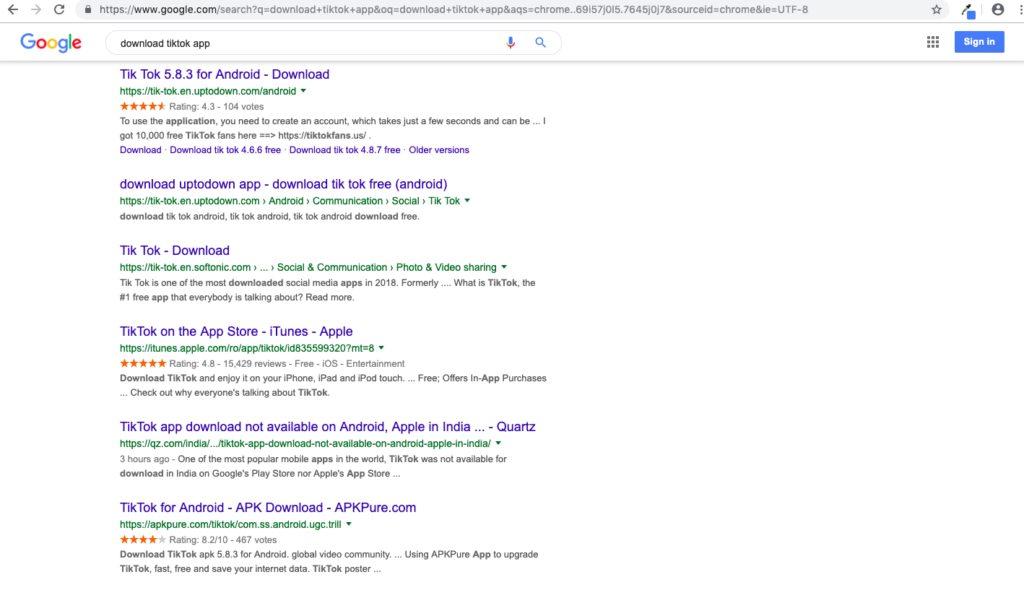The issue of replaceability of source and substitutability of app will not allow to reap the desired benefits from the ban.
Gurugram – Wednesday, April 17, 2019: On the directions of the Honourable courts, the government, MeitY, had asked Google and Apple to pull down the Tik Tok app from their respective stores. This was after increasing unfavourable sentiments across a section of society about the abuse and misuse of such platforms and its far-reaching impact on the youth and children.
However, there are some market and technical realities which will not make the intent effective on the ground and the possible issues and concerns will continue to bother people, especially increasingly worrying parents.
Sharing the techINSIGHT, Faisal Kawoosa, Founder & Chief Analyst, techARC said, “There is a need to have a holistic approach to get rid of such increasing digital menace, which cannot be absolved by technology and/or legal recourse alone.”
Below are some of the major concerns that will restrict the impact of the ban and subsequent removal of the app from the respective market places.
User Base: Tik Tok already has millions of users in India. As per techARC estimates, the existing user base should be in the vicinity of 20-22 million in India alone of this video immersive platform. This is over 5% of the existing Smartphone users in India, estimated to be a little over 390 million. Looking at the appeal and the potential user base of such an app in India, the net penetration of the app among its potential users, would be at least 10-15%. So already a considerable number of potential users are already on the platform.
Replaceability of Source: Any existing user of Tik Tok, who has the app installed on the Smartphone, can share it with any such seeker through apps like ShareIt. One the apk is shared the user can install the app and become a new user.
The other source could be the third-party app stores. Doing a simple google search can give access to such stores, wherefrom a user can install Tik Tok app. There would be hundreds of such third party app installation stores wherefrom a potential user can download the app. Among them 15-20 are very much popular among the tech circles. Some of such names include, apkpure, androidapkbox, uptodown and apkmirror. It will be next to impossible to enforce any law or order with such fragmented markets.


Substitutability of Tik Tok: Tik Tok is not a unique proposition. There are several other alternatives on the app stores like Google Play and Apple App Store, which users can install and start using them for the same purpose. The impact of Tik Tok ban is seen on some other substitutes such as ‘Like’, which is trending at number 3 on April 16th 2019 in India, as per Appannie. Even if somehow, which is as of yet, technically impossible, Tik Tok use is made impossible in India, users will keep on looking for substitutes and replicate the behaviour which has gone to the extent of addiction.

Possible Interventions: Each one in the society has come together and work towards effectively eradicating some of the perils of digital platforms, such as the one Tik Tok is possibly resulting in. Such challenges have implications across the society and need a holistic resolution which can be achieved only by coordinated efforts of all stakeholders.
There is a need to increase awareness about the purpose of such apps and platforms made available digitally. While there is fun and entertainment element in such apps, these could also be used to unleash talent across the country in the fields of dance, acting, singing, journalism, etc. The same platform could be used for skill development and training if steered in right way.
The second intervention could be through adequate parenting. While children should get exposed to technology so that they could possibly become the next digital czars, there is a need to allow it under proper supervision. For instance, by law, no legal contract can be entered into, unless the age of 18 is achieved. Parents are conveniently allowing their kids who have not even crossed 1st decade of life, to use mobile connections with data as well as such devices without any supervision. This exposes them to platforms and apps, which they don’t know how to handle.
It appears that the issues such as emanating from the use of Tik Tok can be resolve more through social interventions rather than judicial and executive orders. There is a need to have a digital awareness programme which could be steered by an industry association representing the digital fraternity in the country along with the support of the corporates through their CSR initiatives. This could be multi-lingual multi-platform awareness and should include extensive awareness camps in schools and colleges.





